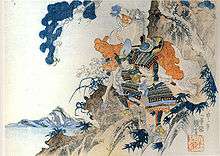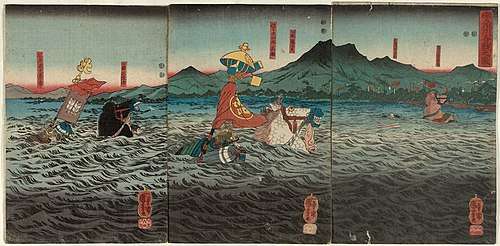Hatakeyama Shigetada
Hatakeyama Shigetada (畠山 重忠, 1164–1205) was a samurai who fought in the Gempei War, in Japan. Originally fighting for the Taira clan, he switched sides to the Minamoto clan for the battle of Dan-no-ura, and ended the war on the winning side.[1]

His Dharma name was Jissan Shūshin Daikoji (實山宗眞大居士).
Biography
Following the war, when his son Shigeyasu was killed by Hōjō Tokimasa, Shigetada spoke up. The reward for this temerity was death, along with the rest of his family.[1] His brave attempt to defend his honor, along with various other acts of strength and skill are recorded in the Heike Monogatari and other chronicles of the period.

In an anecdote from the Heike monogatari, he is described as competing, along with a number of other warriors, to be the first across the Uji River. When his horse is shot in the head with an arrow, he abandons the creature and uses his bow as a staff to help himself across. Just as he is about to climb the bank, however, his godson Okushi no Shigechika asks for help, and is grabbed and thrown ashore by Shigetada; Shigechika then stands tall and proclaims himself the winner, the first across the river.[2]

After the Battle of Awazu in 1184, Shigetada is known for failing to capture Tomoe Gozen.[3]
Notes
- Nussbaum, Louis Frédéric et al (2005). "Hatakeyama Shigetada" in Japan Encyclopedia, pp. 296-297., p. 296, at Google Books
- Kitagawa, Hiroshi et al. (1975). The Tale of the Heike, pp. 511-513; Varley, Paul. (1994). Warriors of Japan as Portrayed in the War Tales, p. 95., p. 95, at Google Books
- Joly, Henri L. (1967). Legend in Japanese Art, p. 540.
References
- Joly, Henri L. (1967). Legend in Japanese Art: a Description of Historical Episodes, Legendary Characters, Folk-lore Myths, Religious Symbolism, Illustrated in the Arts of Old Japan. Rutland, Vermont: Tuttle. ISBN 9780804803588; OCLC 219871829
- Kitagawa, Hiroshi and Burce T. Tsuchida, ed. (1975). The Tale of the Heike. Tokyo: University of Tokyo Press. ISBN 0-86008-128-1 OCLC 164803926
- Nussbaum, Louis Frédéric and Käthe Roth. (2005). Japan Encyclopedia. Cambridge: Harvard University Press. ISBN 978-0-674-01753-5; OCLC 48943301
- Varley, Paul. (1994). Warriors of Japan as Portrayed in the War Tales. Honolulu: University of Hawaii Press. ISBN 9780824815752; ISBN 9780824816018; OCLC 246555065
External links
- Grunwald Center for the Graphic Arts, UCLA Hammer Museum: woodcut print -- "Battle of Uji River" or "Hatekeyama Shigetada fording the Uji River," Utagawa Kuniyoshi (1797-1861)